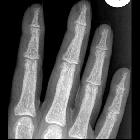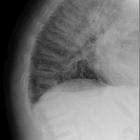subperiostale Knochenresorption

Lost bones:
differential diagnosis of acro-osteolysis seen by the pediatric rheumatologist. Frontal radiograph of the left hand in a 14 year old male patient with hyperparathyroidism demonstrates acro-osteolysis (arrowheads), subperiosteal resorption at the middle phalanges (small arrows), brown tumors (large arrows) and diffuse osteopenia

Hyperparathyroidism
• Subperiosteal resorption - Ganzer Fall bei Radiopaedia

Hyperparathyroidism
• Hyperparathyroidism - musculoskeletal manifestations in the hands - Ganzer Fall bei Radiopaedia

Hyperparathyroidism
• Hyperparathyroidism: subperiosteal bone resorption - Ganzer Fall bei Radiopaedia
Subperiosteal bone resorption is the most consistent and specific finding of hyperparathyroidism and is virtually pathognomonic of the condition.
Radiographic features
While the terminal tufts of the phalanges are the most commonly involved bones, many others are involved:
- tufts of the distal phalanges
- radial aspect of index and middle finger middle phalanges; erosion begins in the proximal metaphyseal region
- bandlike zone resorption of the base of the terminal tuft
- distal end of the clavicles
- medial tibial plateau
- medial humeral neck
- distal ulna
- superior and inferior margins of the ribs (midclavicular line)
- lamina dura of skull and teeth
Siehe auch:
und weiter:

 Assoziationen und Differentialdiagnosen zu subperiostale Knochenresorption:
Assoziationen und Differentialdiagnosen zu subperiostale Knochenresorption:
